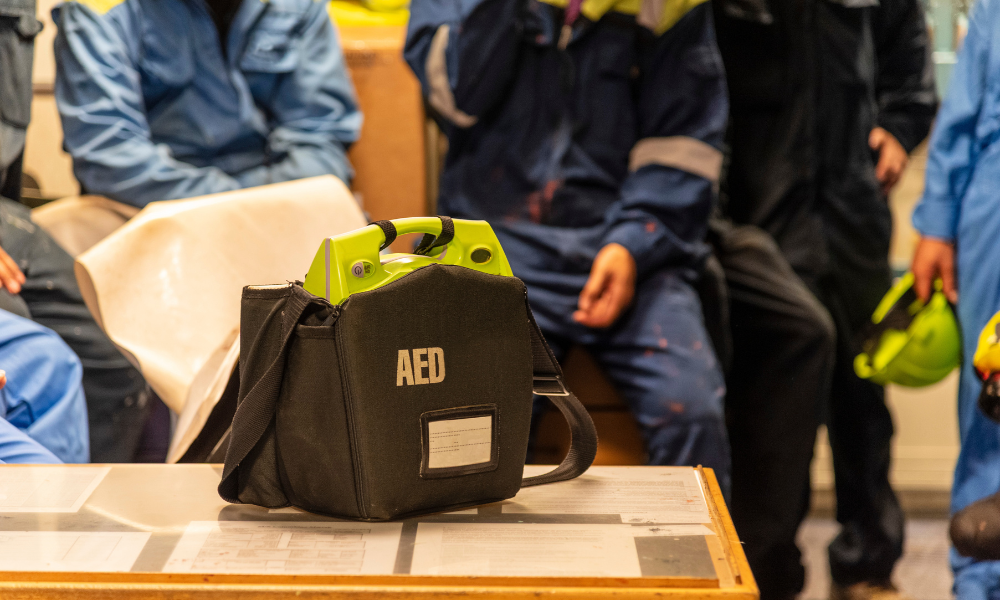Province will require AEDs on projects employing 20 or more workers and lasting three months or longer

Ontario plans to introduce new legislation requiring automatic external defibrillators (AEDs) on construction sites, positioning the province as a national leader in on-site cardiac emergency preparedness.
If passed, the proposed changes would mandate AEDs on construction projects expected to last three months or longer and employ 20 or more workers. The initiative builds on the province’s earlier efforts, including its requirement for naloxone kits in high-risk workplaces.
“Our government led the country with mandatory naloxone kits in high-risk workplaces—and we’re doing it again with defibrillators,” says David Piccini, Minister of Labour, Immigration, Training and Skills Development. “Construction workers help build this province, and they deserve to be protected with real, life-saving tools. Every second counts in a cardiac emergency, and this step will give workers a better chance at surviving if faced with an incident. A safe and healthy workplace is a productive workforce; and we’re continuing to raise the bar for workplace safety while supporting businesses every step of the way.”
Sudden cardiac arrest remains a leading cause of workplace deaths, with construction workers facing a disproportionately high risk. According to ministry data, more than 15% of inspection reports related to cardiac incidents occur in the construction sector. AEDs, when used alongside CPR in the initial minutes following a cardiac arrest, can improve survival rates by over 50%.
To help offset costs, the government proposes a reimbursement program through the Workplace Safety and Insurance Board (WSIB) that would allow constructors to recover the average $2,300 cost of each AED. The funds would come from the WSIB insurance fund.
Industry voices support move
“Having automatic external defibrillators readily available can mean the difference between life and death,” says Jon Lane, CEO of the AED Foundation of Ontario. “This is a vital step toward protecting Ontario’s construction workers. Every second counts in a cardiac emergency, and this proposal is a meaningful step in making job sites safer across the province.”
Marc Arsenault, business manager and secretary-treasurer of the Provincial Building & Construction Trades Council of Ontario, echoes this view. “We support the requirement to have an AED on construction projects with a duration of three months or longer, with 20 or more workers employed on the jobsite. This requirement will help save lives, ensuring that workers can be protected in emergency situations.”
Construction employers are also backing the legislation. Steve Chaplin, senior vice president of health, safety, and environment at EllisDon Corporation, says, “Ensuring the health and safety of workers and the potential need for AEDs provides peace of mind for workers should there ever be a necessity to use one.”
IHSA highlights importance of training and readiness
Enzo Garritano, president and CEO of the Infrastructure Health and Safety Association (IHSA), calls the legislation a “winner of a change.” He says AEDs are a proven and practical tool that enhances emergency readiness on high-risk job sites.
“These AEDs are so good today that they will walk you through the steps,” Garritano says. “The anxiety in using them really goes away thanks to the technology. If it saves one life in its lifespan, then it has done its work”.
Garritano adds that while AED use is not expected to be an everyday event, its availability is critical in emergencies, especially given construction hazards like heat stress, electrical exposure, or struck-by incidents that could lead to cardiac events.
He notes the training aspect is well-supported: “AED training is often embedded in first aid programs. It's not a big stretch for constructors, and it gives workers confidence in their ability to respond during emergencies”.
The AED proposal is set to be part of the seventh iteration of the province’s Working for Workers Act.





